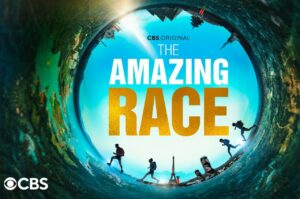Three-Part Series “Life at the Waterhole” Premieres Wednesdays, May 19-June 2, 2021
PBS, in partnership with the BBC Studios Natural History Unit, announced today the premiere of LIFE AT THE WATERHOLE, a new three-part series that explores the daily drama of African wildlife at a unique waterhole rigged with partially submerged and weather-proofed cameras in Tanzania. Created by working with local Hadzabe and Maasai communities and hosted by renowned conservation scientist Dr. M. Sanjayan alongside award-winning wildlife cinematographer Bob Poole, the series premieres Wednesdays, May 19-June 2, 2021 from 8:00-9:00 p.m. ET (check local listings) on PBS, PBS.org and the PBS Video app.
Waterholes are vital to the African ecosystem as bustling oases where elephants, lions, leopards and hundreds of other species meet and compete for water. The competition for existing resources has even led to human-animal conflict. Despite the growing fight for resources, little is known about how these waterholes support so much life. To film LIFE AT THE WATERHOLE, the BBC Studios Natural History Unit and PBS, working with Mwiba Wildlife Reserve and local communities in Tanzania, build an artificial waterhole and outfit it with cameras. Within hours of construction, thirsty animals flock to drink, and the team uncovers the waterhole’s complex dynamics for the first time. Filmed over three periods – the middle of the dry season, the hottest time of year and the height of the first rains – the series reveals dramatic interactions and unlikely rivalries, as well as some unexpected moments of humor. As elephants, warthogs, giraffes, monkeys and big cats jostle for position, scientists gain a greater understanding of the important role of water in Africa as its wildlife faces the growing impact of climate change.
Episode 1 (Wednesday, May 19)
The new waterhole is built in the middle of an open patch of savannah, enabling wildlife to approach from all directions. The team excavates 100 tons of soil, lays five miles of fiber optic cable and pumps in 13,000 gallons of sustainable groundwater. Within an hour, warthogs and elephants discover this new oasis, and soon a cast of wild animal characters keeps coming back. Dr. Sanjayan uncovers the surprising schedule of a day at the waterhole and uses state-of-the-art thermal cameras to record how different animals cool down to survive. As the landscape becomes drier, tensions rise between the two biggest drinkers: elephants and cape buffalo. Cameraman Bob Poole looks at the waterhole’s effect on the wider landscape, including embarking on an adventurous nightime stakeout with Sanjayan to monitor the resident big cat population. As leopards and lions close in, the waterhole quickly becomes a dangerous place.
Episode 2 (Wednesday, May 26)
As the weather heats up, the waterhole becomes busier in the cool of the evening. With remote cameras able to get within close proximity, the team uncovers the new nighttime dynamics. The shift to nocturnal activity brings a new predator out of the shadows: hyenas, creatures so elusive it is hard to know the size of the clan. Their arrival dramatically impacts other predators, and no lions or leopards are spotted while they are around. To discover more about the hyena clan, Dr. M. Sanjayan and wildlife cameraman Bob Poole head into the bush to rig remote cameras to monitor their nearby den. The waterhole is becoming an increasingly risky place for many herbivores, but new bird species continue to flock to the oasis. In an ambitious experiment, Dr. M. Sanjayan and scientist Dr. Meredith Palmer attempt to count the hyenas at night, discovering larger numbers than they ever imagined. As rain clouds gather, another dramatic change is on the horizon, and we meet a very special elephant.
Episode 3 (Wednesday, June 2)
The rains begin to fall, and the area transforms into a lush grazing pasture. This time of year can be harder for predators as prey migrate further and temperatures are more moderate. Using remote cameras, Dr. M. Sanjayan and the team reveal how the hyena clan copes with these new circumstances. Cameraman Bob Poole catches up with some of the waterhole community that is now spread out across the landscape, looking for the freshest grass. With plenty of calories available, now is the time for many species like giraffes to mate. Back at the waterhole, Dr. Sanjayan uncovers a massive shift in the drinking schedule as a great migration of wildebeest heads towards Mwiba Wildlife Reserve. These grazing animals move en masse and require a lot of food and water. Will this put further pressure on the waterhole residents? As the rains continue, it’s not just the landscape around the waterhole that changes. With food and water in abundance, it’s birthing season for many herbivores. But how will an increase in population affect the area? At the end of the rainy season, Dr. Sanjayan delves into the data to discover how animals have used the waterhole across the past three seasons.
LIFE AT THE WATERHOLE is a BBC Studios Natural History Production for PBS and BBC. Series Producer is Anwar Mamon. Executive Producer is Roger Webb. Executive in Charge for PBS is Bill Gardner.
PBS Digital Studios will also launch IN OUR NATURE, a new six-episode series inspired by LIFE AT THE WATERHOLE that reveals the spectacular life and biology of the Serengeti, and what it says about ecosystems in North America. Hosted by Dr. Joe Hanson of PBS’s popular digital series IT’S OKAY TO BE SMART and produced by Spotzen, each episode highlights a major biological principal best understood through life in the Serengeti. Filmed on location in Tanzania and across the United States, the series is co-hosted by Jahawi Bertolli, a 2019 National Geographic Explorer, wildlife filmmaker, photographer and music producer based in Kenya, and features guest appearances from well-known YouTube personalities and science communicators Emily Graslie (The Brain Scoop, PREHISTORIC ROAD TRIP) and Trace Dominguez (Seeker, NATURE “Animal IQ,” Uno Dos of Trace, Star Gazers). The series will launch in the summer of 2021.
About Dr. M. Sanjayan
Dr. M. Sanjayan is a global conservation scientist whose work spans from genetics to wildlife migration to nature’s impacts on human well-being. The CEO of Conservation International, Sanjayan holds a master’s degree from the University of Oregon and a doctorate from the University of California-Santa Cruz. His peer-reviewed scientific work has been published in journals including Science, Nature and Conservation Biology. He is a visiting researcher at UCLA and a distinguished professor of practice at Arizona State University. He is also a Catto Fellow at the Aspen Institute.
Raised in Southeast Asia and West Africa, Sanjayan has attracted widespread media coverage from The New York Times, Outside Magazine and CNN International. His media appearances include NBC’s “Today Show,” “The Late Show with David Letterman,” “CBS This Morning” and “CBS Evening News,” and he has hosted more than a dozen documentaries from PBS, BBC, National Geographic, Discovery and Showtime. Most recently, he hosted the University of California and Vox Media’s Climate Lab series, which garnered over 20 million views. Sanjayan lives in Washington, D.C., with his wife and daughter. When able, he spends time in Montana fly-fishing, or birding and diving around the world.
About Bob Poole, Wildlife Cameraman
Bob Poole grew up in Kenya, where his family spent much of their time with the abundant wildlife that thrived there during the 1960s and 1970s. His career began as a teenager while working on a film about elephants for National Geographic. With a university degree in Earth Science, he became a cinematographer, working around the world on natural history programs. An Emmy Award-winning filmmaker, his extensive credit list includes landmark shows for PBS, BBC and National Geographic. Working on the other side of the camera, Poole fronts shows and live TV for PBS, BBC and National Geographic. He tours with National Geographic LIVE, speaking in cities across the world, and is a Fellow with the Explorers Club.
About PBS
PBS, with more than 330 member stations, offers all Americans the opportunity to explore new ideas and new worlds through television and digital content. Each month, PBS reaches over 120 million people through television and 26 million people online, inviting them to experience the worlds of science, history, nature and public affairs; to hear diverse viewpoints; and to take front row seats to world-class drama and performances. PBS’ broad array of programs has been consistently honored by the industry’s most coveted award competitions. Teachers of children from pre-K through 12th grade turn to PBS for digital content and services that help bring classroom lessons to life. Decades of research confirms that PBS’ premier children’s media service, PBS KIDS, helps children build critical literacy, math and social-emotional skills, enabling them to find success in school and life. Delivered through member stations, PBS KIDS offers high-quality educational content on TV – including a 24/7 channel, online at pbskids.org, via an array of mobile apps and in communities across America. More information about PBS is available at www.pbs.org, one of the leading dot-org websites on the internet, or by following PBS on Twitter, Facebook or through our apps for mobile and connected devices. Specific program information and updates for press are available at pbs.org/pressroom or by following PBS Communications on Twitter.
About the Natural History Unit, BBC Studios Production
BBC Studios Natural History Unit produces the world’s most iconic natural history programmes, such as Blue Planet II and Planet Earth II, which have been watched by more than a billion people globally. Ranging from technically challenging live shows and super-landmarks to long-running series and children’s content, The Natural History Unit programmes include Seven Worlds, One Planet presented by Sir David Attenborough, Primates, Earth’s Tropical Islands, Dynasties, Blue Planet Live, Springwatch, Bears About the House, Andy’s Aquatic Adventures and third-party commissions for Discovery, Apple, NBC, Quibi, National Geographic and BBC America. The Natural History Unit is part of BBC Studios, a subsidiary of the BBC, which develops, produces and distributes bold, British content, making over 2500 hours of content each year, operating in 22 markets globally and generating revenue of around £1.4bn. In the year to March 2019, it returned £243m to the BBC Group, complementing the BBC’s licence fee and enhancing programmes for UK audiences.





